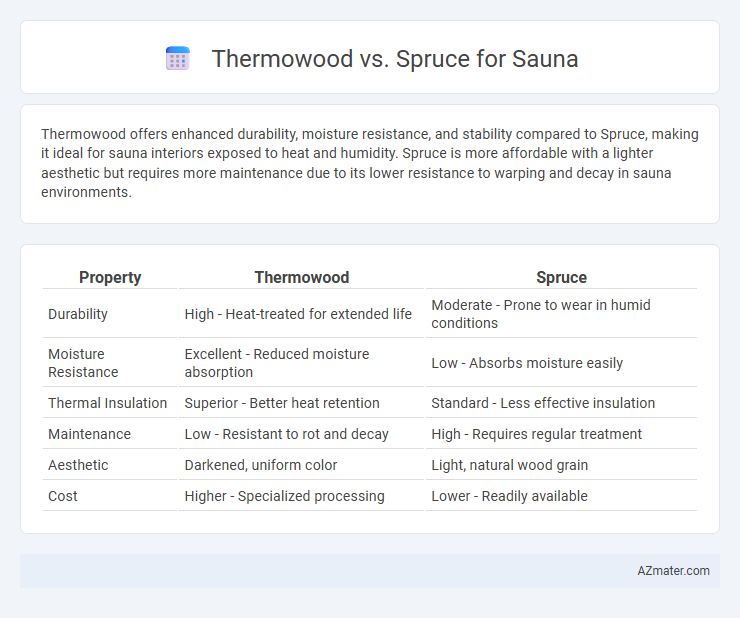Thermowood offers enhanced durability, moisture resistance, and stability compared to Spruce, making it ideal for sauna interiors exposed to heat and humidity. Spruce is more affordable with a lighter aesthetic but requires more maintenance due to its lower resistance to warping and decay in sauna environments.
Table of Comparison
| Property | Thermowood | Spruce |
|---|---|---|
| Durability | High - Heat-treated for extended life | Moderate - Prone to wear in humid conditions |
| Moisture Resistance | Excellent - Reduced moisture absorption | Low - Absorbs moisture easily |
| Thermal Insulation | Superior - Better heat retention | Standard - Less effective insulation |
| Maintenance | Low - Resistant to rot and decay | High - Requires regular treatment |
| Aesthetic | Darkened, uniform color | Light, natural wood grain |
| Cost | Higher - Specialized processing | Lower - Readily available |
Introduction: Comparing Thermowood and Spruce for Saunas
Thermowood and Spruce are popular wood choices for sauna construction due to their durability and heat resistance. Thermowood undergoes a thermal modification process that enhances its stability, moisture resistance, and lifespan, making it ideal for high-humidity sauna environments. Spruce, a softwood with light color and fine grain, offers affordability and natural insulation but requires careful maintenance to prevent warping and decay in sauna conditions.
What is Thermowood? Key Characteristics
Thermowood is wood that has undergone a controlled heat treatment process, enhancing its durability and resistance to decay, making it ideal for sauna construction. Key characteristics include increased stability, reduced moisture content, and improved insulation properties, which contribute to a comfortable sauna experience. Compared to spruce, Thermowood offers superior dimensional stability and longevity under high heat and humidity conditions typical of saunas.
Understanding Spruce: Properties and Uses
Spruce, a softwood commonly used in sauna construction, offers a light color and fine grain that enhance sauna aesthetics while providing good thermal insulation properties. Its natural resistance to moisture and moderate durability make it suitable for interior sauna walls and ceilings where consistent heat and humidity levels are maintained. Compared to Thermowood, spruce requires more maintenance but remains a cost-effective, traditional option for sauna builders prioritizing breathability and a natural wood scent.
Durability and Longevity in Sauna Conditions
Thermowood offers superior durability and longevity for sauna use due to its enhanced resistance to moisture, decay, and high temperatures, outperforming traditional spruce in harsh sauna conditions. The thermal modification process of Thermowood stabilizes the wood structure, reducing warping and cracking over time, which is crucial for maintaining sauna integrity. Spruce, while commonly used for its affordability and aesthetic appeal, tends to absorb more moisture and degrade faster, resulting in shorter lifespan and increased maintenance in sauna environments.
Moisture Resistance and Water Absorption
Thermowood exhibits superior moisture resistance and significantly lower water absorption compared to Spruce, making it a preferred choice for sauna construction. The thermal modification process reduces Thermowood's hygroscopicity, enhancing durability and dimensional stability in humid sauna environments. Spruce, while commonly used due to affordability, tends to absorb more water, leading to faster wear and potential deformation under repeated sauna conditions.
Thermal Insulation Performance
Thermowood sauna panels offer superior thermal insulation compared to spruce due to the heat-treated process that reduces moisture content and increases wood stability. The improved cellular structure of Thermowood enhances heat retention and energy efficiency, making it an optimal choice for maintaining consistent sauna temperatures. Spruce, while commonly used, has higher thermal conductivity, which results in faster heat loss and less effective insulation in sauna environments.
Aesthetics: Color, Texture, and Appearance
Thermowood offers a rich, warm brown hue that deepens over time, providing a luxurious and consistent aesthetic for sauna interiors compared to the pale, natural cream color of spruce. Its textured surface is slightly rougher yet more stable, enhancing visual interest without warping, while spruce features a smoother texture but is prone to knots and discoloration that may affect the overall appearance. The thermal modification process of thermowood also reduces resin content, resulting in a cleaner, more uniform look that is prized in high-end sauna design.
Maintenance Requirements: Thermowood vs Spruce
Thermowood sauna wood requires minimal maintenance due to its enhanced durability and resistance to decay, reducing the need for frequent treatments or repairs. Spruce, being a softer and less stable wood, demands regular maintenance such as sealing and protective coatings to prevent moisture damage and warping. Choosing Thermowood over Spruce for sauna construction significantly lowers long-term upkeep efforts and costs.
Health and Safety Considerations
Thermowood offers enhanced resistance to moisture, mold, and fungal growth compared to spruce, making it a safer choice for sauna environments prone to high humidity. Its heat-treated properties reduce the risk of harmful chemical emissions, ensuring better indoor air quality and minimizing potential skin irritation during use. Spruce, while traditional and cost-effective, requires careful maintenance to prevent mold and may release allergens or resins under high temperatures, impacting overall health and safety.
Cost Comparison and Overall Value
Thermowood offers higher durability and resistance to moisture compared to spruce, making it a premium but more expensive option for sauna construction. Spruce is significantly more affordable and widely available, providing decent thermal insulation but lower longevity under humid conditions. When balancing cost and overall value, Thermowood's extended lifespan and reduced maintenance often justify the initial investment despite its higher price.

Infographic: Thermowood vs Spruce for Sauna
 azmater.com
azmater.com